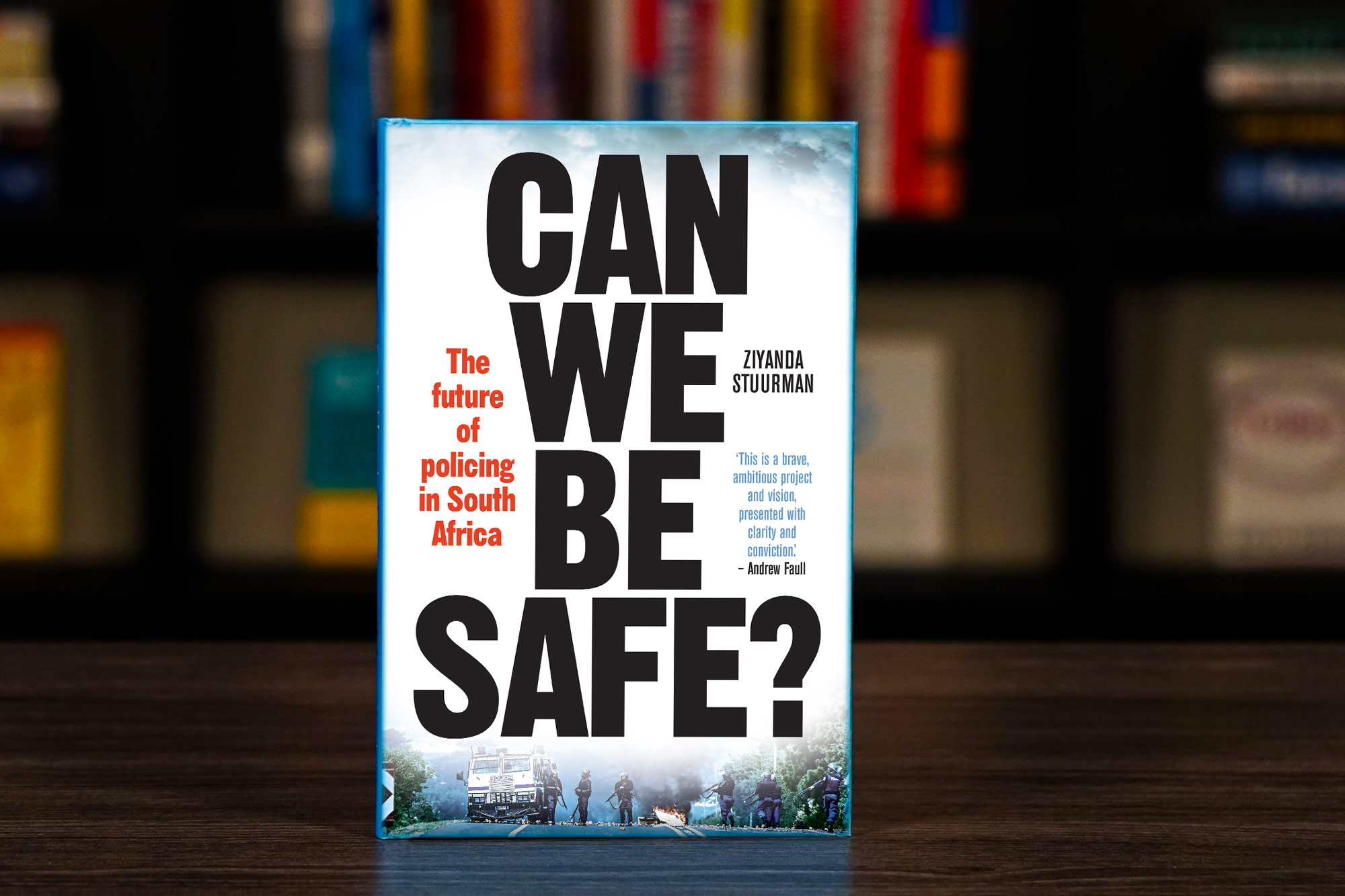New Books | The Future of Policing in South Africa
Postapartheid prisons tried to make a clean break from their punitive colonial and apartheid pasts, but rehabilitation programmes have mostly failed to garner public buy-in.
Author:
2 August 2021

This is a lightly edited excerpt from Can We Be Safe?: The Future of Policing in South Africa (Tafelberg, 2021) by Ziyanda Stuurman.
The purpose of prisons
The first prisons in South Africa were built as forced labour camps. Under colonialism, prison labour was used in the development of roads, railways, farms and forestry, and after the discovery of gold and diamonds, prison labour was often used in the mining industry. After slavery was abolished in the country on 1 December 1834, Black prisoners were often outsourced to private farms for farm and outdoor work, thereby reinforcing the capitalist exploitation of labour under the guise of correcting behaviour that had been criminalised. The idea of prisons being places of rehabilitation first emerged in South Africa with the arrival of John Montagu, a British colonial prison reformer who took up the role of colonial secretary of the Cape in 1843. Inspired by reforms in other colonial frontiers, Montagu formalised an organisational and ideological prison system built on the idea of rehabilitation.
However, even with the establishment of this system, prison farms and mine compounds regularly made use of forced labour and conditions on these sites were exploitative and harsh, and administrators on these sites were rarely if ever held accountable for the abuse of prisoners. Even during the apartheid regime, when abuse was rampant in the prison system because of how isolated and unseen people in prisons were, the regime at the time published documents that waxed lyrical about the role of the prison as a place for good in society, a theory that was in line with the ideal-type international prison agenda. In a 1969 document, the South African Prison Service asserted:
“The policy of punishing merely to deter has lost much of its appeal, and the emphasis has gradually shifted to reforming those violating the rules of society, and to giving them the opportunity to become full and useful members of society again. This holds true for South Africa, where for decades, a progressive policy has been followed, based not only on using incarceration merely for detaining the prisoner … but as an opportunity for rehabilitating him.”
Related article:
Everything the apartheid regime said was, of course, complete nonsense. The apartheid propaganda machine was intent on presenting South Africa’s entire racist, segregationist and brutal system of government as acceptable and palatable to a mostly white and international audience when it was nothing of the sort. If there were any parts of the country’s prison system that were rehabilitative in nature and aimed at facilitating the reintegration of former offenders back into public life, they were reserved for white prisoners and white prisoners only. In fact, under apartheid, thousands of Black prisoners – including those who contravened the petty pass laws at the time – were handed over to farmers as labour. Prisoners were also often placed on farm outstations. It was only after local and international pressure that prison labour was phased out in the country and prison outstations were closed in 1988. In its all-encompassing vision of South Africa after colonialism and apartheid, even in 1955, the Freedom Charter explicitly rejected the use of imprisonment as a form of vengeance, but it went even further and also declared that “forced labour and farm prisons shall be abolished” in its assertion of rights for all those who work the land.
The prison as a place and institution in South Africa was built to reproduce violence and to further the entrenchment of the racial hierarchy established during colonialism and apartheid. In the South African context, if the criminal justice system is thought of as a pipeline built first by colonial administrators and then successive apartheid governments – and one that explicitly filtered Black, coloured and Indian people into the definition of criminals and criminality through the court system as explained in the previous chapter – then the prison was an important location in that pipeline. The development of both a colonial capitalist social order that was established and enforced by the police and court system, then had the prison as a place and institution to carry out the punishment for violating that social order either through attempted disobedience, insurrection or agitating for disruption of the status quo. As Florence Bernault succinctly described, prisons were built to further colonial conquest across Africa:
“Colonial prisons never served as true penitentiaries, but as practical fortresses where the conquest of Africa could be safely pursued … [Colonisation] imported the modern prison in Africa severed from the very principles that had presided over its birth. Instead of seeking to rehabilitate criminals and promote social stability through popular consent over legal punishment, Europeans used the prison to secure control over a subaltern [lower status], racially defined social category that comprised the majority of the population.”
Related article:
The purpose of highlighting the history of prisons in South Africa is to shatter any notion that prisons were built for the purpose of delivering justice to victims, or deterring criminals from engaging in future crimes, or even rehabilitating offenders to welcome them back into mainstream society. As with quite literally everything in our history and the history of the Global South in relation to the world, our prisons are a function of violent and exploitative racial capitalism. Mirroring the history of policing in the country after 1994, there has only ever been one small sliver of time when the idea of wholesale, deliberate and purpose-driven reform of the prison system was attempted. With the adoption of the Constitution in 1996 – and especially the provisions within the Bill of Rights – there was a fundamental paradigm shift in the philosophy around imprisonment and the treatment of prisoners in democratic South Africa. This was because the apartheid regime had built much of its state security apparatus and the enforcement of apartheid on a sprawling system of prisons for racist subjugation, crushing anti-liberation movement campaigns and the project of supplying cheap Black labour for white capital. The state used detention without trial, torture and interrogation, and the death penalty for anti-apartheid activists frequently and with enthusiasm. In the early 1990s, many of the incoming public office-bearers and government officials had personal experiences with apartheid regime detention and prison facilities, and as such, legislative and policy measures towards meaningful prison reform were prominent in the early days of democratic statebuilding.
As with police structures, the prison administration system underwent a demilitarisation process in April 1996. To signal a clear break with the old system and the old way of doing things, the Department of Prisons was renamed the Department of Correctional Services, and the military drills, ranking systems, codes of formal greeting, insignia and other markers of military culture were abandoned. In November 1998, the Correctional Services Act was introduced, and it represented South Africa’s commitment to and the application of international standards of imprisonment within the context of local conditions. The Act was also written and designed to govern the rights, treatment and conditions of all prisoners within a human rights context. Sociologist Kelly Gillespie’s doctoral research on the prison in postapartheid South Africa reveals how policy and legislative changes aimed at demilitarisation sent shockwaves through the system, but ultimately the hard work of ensuring institutional reform every day was piecemeal and mismanaged, and led to many stakeholders in the process doubting the substantive change possible through the process. Gillespie asserts it was only after new leadership was elected to the Department of Correctional Services in 2002 that a coherent vision for a postapartheid prison began to emerge. The 2004 White Paper on Correctional Services aimed to place the work of “corrections” at the centre of the prison’s purpose and sought to have prisons be understood as “spearheading the moral recuperation of South African society”.
Related article:
Even with this new direction and efforts made towards institutional and policy reform, the “work of corrections” in South Africa cannot be viewed as only a moralistic or individual endeavour. A substantial point of criticism of the prison system’s efforts to rehabilitate offenders lies in the idea that criminal justice systems do not acknowledge that those who end up incarcerated come from poor neighbourhoods that have been deliberately and systematically impoverished by decades of structural and explicit violence themselves. There is a significant amount of literature on prisons and their place in society that argues that the prison as a method of punishment has consistently failed in its aims of rehabilitation and reform of the individual offender, and that, actually, what the prison does is successfully consolidate the class and racial interests that always accompany the bureaucracies built around mass incarceration. Therefore, the idea of “correcting” the criminal is then purposefully divorced from larger structural and historical processes – and therefore divorced from reality – in order to advance the idea that crime and criminal offenders can be individualised and addressed through ideas of morality, “the home”, “the family” and “reversing moral degradation”. Gillespie’s work on the role of morality and nation-building in the context of the Department of Corrections and the prison system it upholds is important to help contextualise why the vision of corrections in South African society is flawed and represents yet another cog in a machine – or place in a pipeline – that is either broken, or working perfectly as it was intended to, depending on your perspective of the instruments the state uses to enforce social control and the historical social order.
For the purposes of this book and the larger discussion on crime and justice and community safety, it is quite obvious that the origins and continued operation of the prison system has nothing to do with us, the public. Driven by our fears and anxieties, many of us have given up on the idea that prisons are places of rehabilitation; in fact, as Patricia Manganye found in her master’s thesis research on rehabilitation programmes in maximum correctional facilities in the North West, “people regard correctional institutions as schools of crime where offenders learn new ways of committing crime”. Instead of believing they can be rehabilitated, we want to see criminals get their comeuppance, their just deserts, and what we feel they deserve in the time they spend in prison. Because so few criminals are arrested and tried and convicted, we look at every person in prison as deserving of whatever happens to them there. Our views on “justice” also often reflect feelings of powerlessness and our need to take back as much power as we can with every successful prison sentence handed down and announced in the media. In this sense, we don’t see individual people accused of crime, those remanded in custody and those convicted and sentenced to prison time as people: we see them as examples of a failing criminal justice system that works sometimes.



